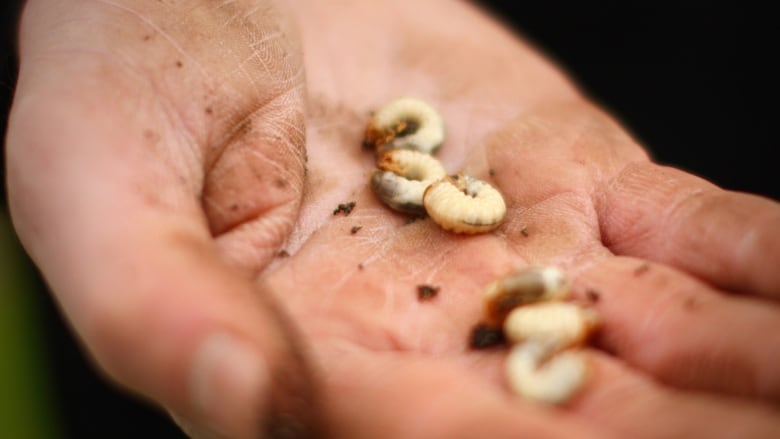"What's happening to my lawn?"
Saint John resident Kayla Stevens has been asking herself this question for days now, and she's not alone.
Across New Brunswick, residents are surveying their yards and seeing vast patches of bare dirt, peeled-back chunks of sod, and clumps of torn-up grass strewn everywhere.
It's as if someone, or something, has gone on a wanton marauding spree.
Which, in fact, they have.
Welcome to spring. Or as raccoons, skunks, crows and other hungry hunters know it: grub season.
Beneath the soil's surface, the pasty-white larvae of invasive chafer beetles — a species that includes June bugs — are feasting on grass roots, plumping up delectably and irresistibly for the critters above ground.
Grub season is a double-whammy for lawns, and it happens every year at this time to some degree.
But this year, lawn-care experts say, it's a doozie.

'If there's one, there's probably 1,000'
Zachary Munn can tell just by looking at a lawn whether there's a grub problem beneath it.
And the sky is a pretty good indicator too.
"Sometimes I'll drive by and watch what the birds are doing," said Munn, owner of Valley Plus Lawncare in Quispamsis.
If he sees them diving down and plucking fat white morsels out of a lawn, "then I know they definitely have grubs," he said.
"And if there's one, there's probably a thousand."
This year, the birds are feasting in Quispamsis.
"It's terrible. It's one of the worst years I've ever seen," Munn said, noting he has seen lawns where "you can pick out 50 of [the grubs] in just a square foot."

Munn said a number of factors are driving this year's bumper crop of pests, starting with the weather.
The beetles lay their eggs in late June, and the young grubs begin feeding on grass roots within weeks.
A dry July and August can kill off many of the eggs, but much of New Brunswick had a soaker of a July last year, so there was no shortage of grubs, or grass roots to feed on, into fall, when the grubs then burrow deep into the ground for the winter.
A warmer-than-usual winter helps grubs get an early start feeding on grass roots, which they'll keep doing until late May, when they transform into June bugs and begin laying eggs and starting the cycle all over again.
From then on, it's simple math, Munn said.
"They keep on repopulating … every year, so you can get thousands and thousands of them, and then they turn into millions and they turn into billions," he said.
"A few years ago, it just started out as one lawn in the neighbourhood, and now every lawn in the neighbourhood has it. It spreads rapidly."
Some opt to just let it be
Hampton resident Richard Blacquiere admits he's intrigued by the number of dishevelled and dug-up lawns he's seen in his neighbourhood, including his own.
"Part of my regular daily walk is through the Hampton Rural Cemetery, and I started noticing patches there," he said.
Within days, he was seeing patchy lawns everywhere.
"There's some fairly large patches now …and it seems to be growing every day."
When the patches started appearing in his own yard, he set up a camera and let it run overnight.
As he suspected, a raccoon was one of the first bandits on scene, where his camera caught it feasting on worms and grubs and other underground goodies.
"The raccoons are the most efficient, they actually roll up the sod," Blacquiere said. "It's quite amazing to watch them."
But he is quick to note he's not planning on calling a lawn company to treat it. He'd rather just let nature run its course.
"It's just part of the normal cycle," he said. "I'm not too worried about my lawn. It'll save mowing it."

What you can do about it
While some prefer the live-and-let-live approach to lawn care, others, like Stevens, just want the grubs gone so they can get their "pretty" lawn back.
So how do you do that?
In extreme cases, Munn said he will rip up the entire lawn, treat the soil with either chemical or organic pest controls and then replant it with hydroseed, a slurry of mulch and seed.
According to Health Canada, which has a "pest control tips" section on its website, "the best thing you can do is to make sure your lawn is healthy" before problems can take root.
"Healthy, vigorously growing lawns can tolerate more grub feeding than stressed lawns, because damage to one root is made up for by others," the agency advises. "Remove excessive thatch, and aerate compacted soil areas to ensure proper drainage."
It also advises raising your summer lawn-mowing height to six to eight centimetres (2½ to three inches) to discourage beetles, which prefer to lay eggs in closely cropped lawns.
"Leave lawn clippings after mowing, because their slow release of nitrogen encourages micro-organisms to break down the thatch [and] use fertilizer with high potassium and enough nitrogen."
Grubs, and the critters that eat them, are turning N.B. lawns upside down - CBC.ca
Read More


No comments:
Post a Comment